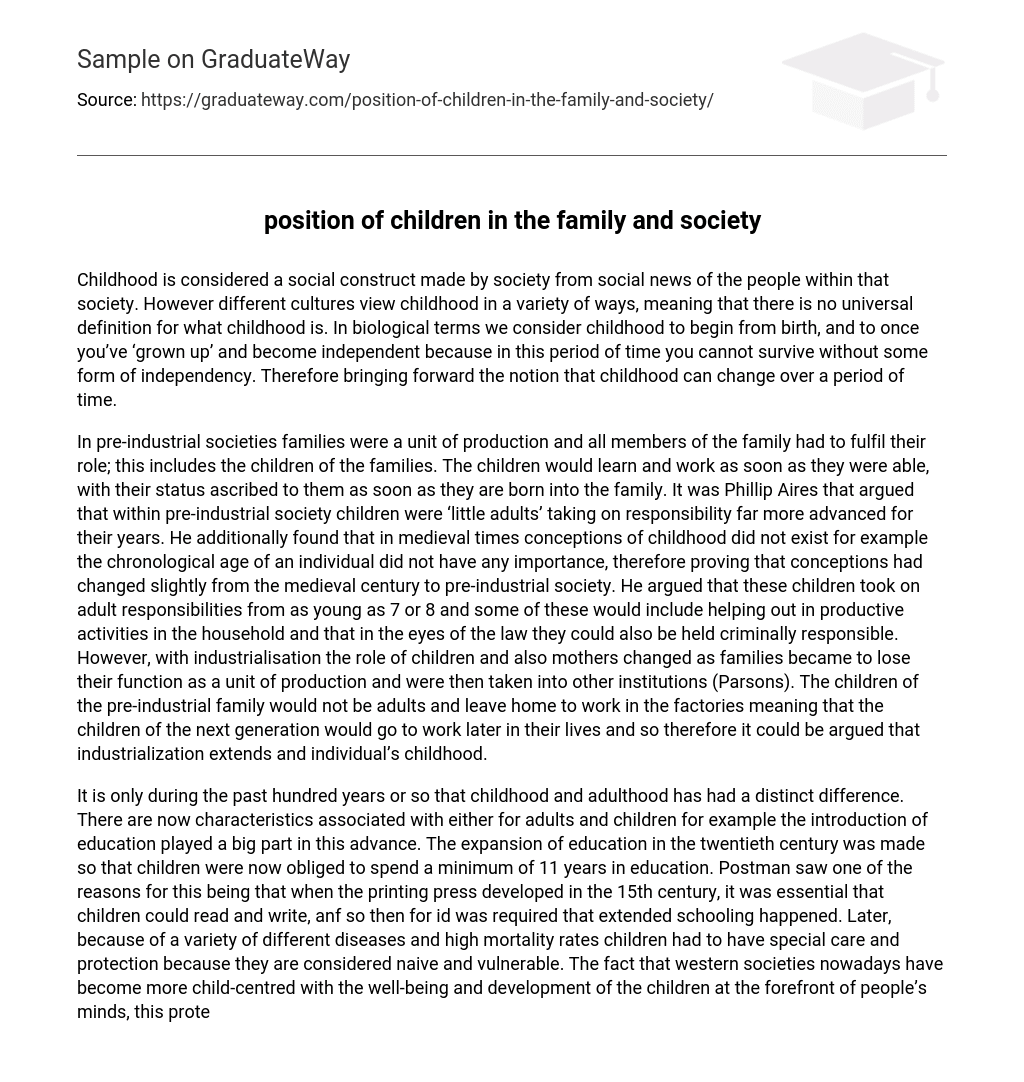Childhood is a construct of society, shaped by the social norms and values of a given culture. Various cultures hold diverse perspectives on childhood, thus lacking a universally accepted definition. From a biological standpoint, childhood commences at birth and extends until an individual attains independence and reaches adulthood as they rely on others for their survival during this period. Consequently, the concept of childhood can evolve over time.
In pre-industrial societies, families were responsible for production and all family members had specific roles, including children. Children would start learning and working as soon as they were able, with their social status determined from birth. Phillip Aires argued that in pre-industrial society, children were seen as “little adults” and given advanced responsibilities for their age. He also discovered that during medieval times, the concept of childhood did not exist. The individual’s age had no importance, showing a slight change in perception from the medieval period to pre-industrial society. Aires claimed that these children took on adult responsibilities at an early age of 7 or 8, which included helping with productive tasks at home. Legally, they could also be held accountable for criminal actions. However, industrialization caused changes in the roles of children and mothers as families lost their role in production and became integrated into other institutions (Parsons). As a result, children from pre-industrial families didn’t become adults and leave home to work in factories. This led to the next generation entering the workforce later in life, indicating that industrialization prolongs an individual’s childhood.
In the past century, childhood and adulthood have become distinct from each other, with specific characteristics associated with each stage. The introduction of education has played a significant role in this differentiation. Education expanded in the twentieth century, requiring children to spend at least 11 years in school. According to Postman, this expansion was necessary because of the development of the printing press in the fifteenth century which made literacy essential for children. As a result, extended schooling became necessary.
Furthermore, due to diseases and high mortality rates – where children were vulnerable and naive – they required special care and protection. Nowadays, Western societies prioritize the well-being and development of children leading to a more child-centered approach where protection and care are now considered normal.
The protection of children has been ensured through various acts, including the 1989 Child Protection Act. This act was implemented because it became evident that children are unable to care for themselves. Despite these measures, there are still instances where children have fallen through the system, as seen in the Baby P case. However, these incidents prompt governments to strengthen such acts, like the 2004 Child Protection Act. Furthermore, the fact that the victim’s name is always known while the perpetrator remains anonymous suggests a positive shift in society’s perception and value of children. Aries’ research reveals that in medieval times, the death of a child was not grieved, emphasizing this change for the better.
According to Frank Furedi, our world is characterized by uncontrollable institutions such as government, media, education, and religion. Consequently, exposing children to media exaggerations about beauty, drugs, and gangs poses significant risks. These influences are now more accessible to children than ever before and have led to an increase in child crime. Furedi argues that children are becoming increasingly adult-like not only in their work but also in their actions and attitudes. Drug use and gang involvement, typically associated with adulthood, have become prevalent among children. The sexualization of children has also become a widespread issue evident through the rise of beauty pageants for young girls. Feminists suggest this is due to the socialization of boys and girls into specific gender roles from a young age.
Angela McRobbie’s study on Jackie Magazine during the 1980s supports this viewpoint. She found that the magazine exclusively focused on topics related to marriage and motherhood, leading teenage girls at that time to perceive these roles as societal norms for women’s lives. While current teenage magazines emphasize careers instead, indicating a shift in children’s roles compared to pre-industrial times, it is important to acknowledge that this change differs from historical norms where marriage and motherhood were prioritized over pursuing careers after completing education.
According to some sociologists, the increasing rights of children have led to greater similarities with adults, resulting in a blurred boundary between the realms of child and adult. Postman argues that the concept of childhood has vanished due to media and technology’s impact, which has erased boundaries, leaving only a biological difference. The growing affluence in society may have greatly influenced ideas about childhood. However, we cannot claim that childhood no longer exists because children still rely on their parents for upbringing, care, and support in both material and emotional aspects.





